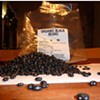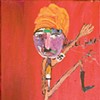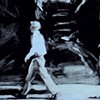Published October 14, 2009 at 5:22 a.m.
The most popular place in Hardwick these days is not the pizza place, the bookstore or even Claire’s Restaurant. The numero uno venue is a hole-in-the-wall cellphone store. Tiny school kids, pimply teenagers, stressed-out adults — I’ve seen them all there, begging for Blackberries and the like. It’s the first thing every kid with cheapskate parents saves up for, and the last thing anyone over 12 wants to live without.
And you know that if the 24/7 tether is de rigueur in rural Vermont, it’s truly universal. The whole world is chattering and Tweeting away.
Proof positive that the mobile has gone global: A gallery in another rural Green Mountain town — Stowe — has attracted people worldwide to participate in one of the first cellphone photography shows held in the U.S.
Odin Cathcart, the new exhibitions director of the Helen Day Art Center, invited thousands of ordinary, on-the-fly-image-snapping cellphone users to send their favorite pics for the show he dubbed “The Relentless Eye: Global Cellphone Photography 2009.” Cathcart gave it the full-court Internet press — he advertised on 50 call-to-artist websites, Twittered and Facebooked for a solid week, and posted Craigslist notices on every continent but Antarctica. Then he waited.
Cathcart admits the project took on a life of its own. In just five weeks, Helen Day received more than 1500 entries from all over the planet — Turkey, Indonesia, India, Dubai, New York City, San Fransciso. Then guest curator Eirik Johnson, assistant professor of photography at the Massachusetts College of Art and Design, whittled them down to 134 selections.
The parameters? Each image had to be either 800 by 1000 pixels per inch or 8 by 10 inches, and submissions must cite the name of the photographer and a title.
How does Cathcart know where the images come from? Turns out every cellphone photo is tagged with tracking metadata that lists the GPS coordinates where it was taken. One of the images Cathcart indicates was shot in the middle of the San Francisco Bay — he just applied the coordinates to Google Maps to get the location. As soon as you tweak the photo, though — say, adjust the exposure in Photoshop — the data disappears.
That’s part of what’s interesting about the show, too. Many of the images haven’t been doctored at all. Cellphone cameras take less-than-perfect stills — the shots are often grainy, control of exposure is limited, cropping tools are nil, etc. Yet even professional photographers are beginning to use the form precisely because of its flaws, much as they once took an interest in the plastic cameras of the 1950s.
Five artists from around the country were invited to submit work to “The Relentless Eye,” as well. It’s interesting to note that, although their attention to detail and sense of composition are more refined, the essential snapshot quality and spontaneity of their work doesn’t differ much from that of the amateurs in the next room.
Ultimately, that sense of impromptu authenticity carries the show. Take the work of Shawn Rocco, a photojournalist from Raleigh, N.C., who regularly reaches for the cellphone in his pocket over his high-end SLR. He used it to shoot an artsy take on a Waffle House sign, and a couple of middle-aged men at a groundbreaking ceremony, wearing suits and construction helmets and smiling each other as they hold shovels bedecked with ribbons.
Christopher Greene, a photographer from New York City (and Cathcart’s brother), takes evocative, slightly blurred subway shots of interactions among perfect strangers. Wafaa Bilal, a professor of new media at the Tisch School of the Arts at New York University, used a clandestine cellphone to record his first visit home to Najaf, Iraq, in 18 years.
As for the amateurs, their surprisingly emotional images stand out from the more common moody landscapes and abstracts: a little girl sticking her tongue out, a woman blowing a gum bubble, three kids blissed out in front of the TV.
It’s hard not to conclude from the show that, when it comes to shooting, size matters. When the camera is tiny, people are less likely to stiffen up and pose for it, particularly if they think the photographer is just busy texting. So much the better for voyeurs everywhere, particularly those with cellphones in hand.
More By This Author
Speaking of Art,
-

Q&A: Catching Up With the Champlain Valley Quilt Guild
Apr 10, 2024 -

Video: The Champlain Valley Quilt Guild Prepares for Its Biennial Quilt Show
Apr 4, 2024 -

Q&A: Meet a Family in Waterbury That Embraces Halloween Year-Round
Feb 14, 2024 -

Video: Goth Family in Waterbury: Sarah, Jay and Zarek Vogelsang-Card
Feb 8, 2024 -

Q&A: Art Entrepreneurs Tessa and Torrey Valyou Celebrate 15 Years of New Duds
Oct 11, 2023 - More »
Comments
Comments are closed.
From 2014-2020, Seven Days allowed readers to comment on all stories posted on our website. While we've appreciated the suggestions and insights, right now Seven Days is prioritizing our core mission — producing high-quality, responsible local journalism — over moderating online debates between readers.
To criticize, correct or praise our reporting, please send us a letter to the editor or send us a tip. We’ll check it out and report the results.
Online comments may return when we have better tech tools for managing them. Thanks for reading.














































